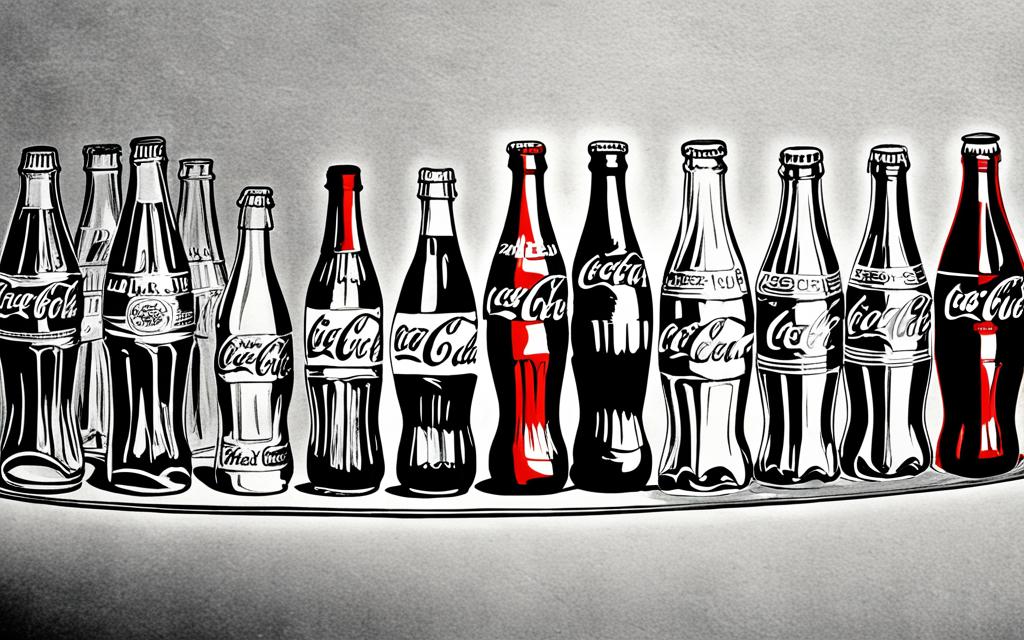Table of Contents
The history of brand logos is a fascinating journey that spans centuries, reflecting the evolution of design, technology, and cultural trends. From ancient civilizations to modern multinational corporations, logos have played a pivotal role in creating brand identities and communicating with consumers.
Logos have come a long way, starting from intricate and complex designs to simple and recognizable marks that leave a lasting impression. They have evolved alongside advancements in technology and changes in visual aesthetics. As we delve into the historical perspective of brand logos, we gain insight into their significance and enduring impact.
Notable designers like Paul Rand and Carolyn Davidson have greatly influenced the logo landscape, leaving behind a legacy that continues to shape the industry. These designers understood the power of symbolism in logo design, harnessing it to convey deeper meanings and appeal to the emotions of the audience.
With the Visual Age upon us, where images and visuals have become increasingly important, logos are more crucial than ever. They are vital in capturing the attention of consumers and conveying messages quickly and effectively. As technology advances and cultural trends evolve, brand logos will continue to adapt to the changing needs of the modern world, ensuring their relevance in the ever-evolving marketing landscape.
Join us on this journey through time as we explore the fascinating history, symbolism, and impact of brand logos.
The Power of Symbols in Logo Design
Symbols have an incredible influence on logo design. They draw upon centuries of signs and symbols, including the alphabet, to convey meaning and evoke deep emotions. Logo designers possess the ability to tap into the collective consciousness and cultural references of viewers by utilizing symbols. For instance, the image of an apple can symbolize various concepts such as nature, food, or even technological innovation. Symbols within logos are highly subjective and depend on cultural context. The meaning of a logo can vary from person to person, resulting in a subjective interpretation. This subjective nature of meaning in logos contributes to the beauty and wonder of logo design.
By employing symbols, brand logos can communicate complex concepts and emotions in a concise and visually compelling manner. These symbols harness the power of visual communication, transcending language barriers and making a lasting impact on audiences. When viewing a logo, individuals often draw upon their personal experiences, cultural backgrounds, and associations with particular symbols. Consequently, a well-designed symbol can instantly establish a connection, provoke an emotional response, and leave a memorable impression on consumers.
“Symbols have a remarkable ability to transcend language and cultural barriers. They provide a visual shorthand that enables logos to communicate complex ideas and evoke deep emotions effortlessly.”
Historical Identifying Marks
Throughout history, various stamps, symbols, and signatures have been utilized as historical identifying marks for individuals and organizations. These marks have evolved over time, adapting to the social, cultural, and technological changes of different eras.
In the past, royal courts used family crests, uniforms, and religious symbolism as a means to invoke identity and unity. These symbols represented the lineage, rank, and allegiance of individuals within the court. Family crests, with their intricate designs and symbolic elements, served as visual representations of noble families.
Religion also played a significant role in historical identifying marks. Churches and religious organizations used symbols to signify their beliefs and values. The Christian cross, for example, served as a powerful symbol of faith and redemption.
As societies progressed, the modern logo design emerged in the 20th century alongside the rise of brands and corporations. Logo design became a strategic tool for projecting a cohesive image for multinational corporations. The concept of corporate identity became essential for distinguishing brands in a competitive market.
“Symbols have the power to evoke emotions, communicate values, and create a sense of identity. In logo design, symbolism plays a crucial role in conveying a brand’s message.”
| Historical Identifying Marks | Logo Design | Symbolism |
|---|---|---|
| Famly crests, uniforms, religious symbolism | Strategic tool for projecting a cohesive image | Powerful means to evoke emotions and communicate values |
| Influence of royal courts and religious organizations | Development of corporate identity | Creation of a sense of identity and unity |
Logo designers draw inspiration from these historical identifying marks and incorporate symbolism into their designs. By utilizing symbols in logo design, designers tap into the power of visual communication and connect brands with their target audience on a deep, emotional level. The use of symbols in logos allows brands to convey their values, aspirations, and identity.
Symbolism adds layers of meaning to a logo, making it iconic and memorable. It creates a visual language that speaks to the viewers and conveys a specific message or represents a particular attribute associated with the brand. Through skillful use of symbolism, logo designers create logos that are visually appealing, meaningful, and evoke the desired responses from consumers.
“Logo designers must carefully consider the historical context, cultural references, and intended message of a brand while incorporating symbolism into their designs.”
In conclusion, historical identifying marks have significantly influenced logo design and the use of symbolism. From ancient royal crests to modern brand logos, the power of symbols in communicating identity and evoking emotions remains undeniable. Logo designers continue to draw inspiration from history, incorporating symbolism into their designs to create unique and meaningful logos that resonate with consumers.
Identity Masters
Influential designers have played a significant role in shaping the graphic identity of consumer culture in the second half of the 20th century. Paul Rand, Milton Glaser, and Alan Fletcher are among the notable identity masters who have made a lasting impact on logo design. Through their innovative approaches, they have created iconic logos that continue to resonate with consumers today.
Paul Rand, often referred to as the father of modern logo design, revolutionized the industry with his minimalist and timeless approach. As the designer behind logos for IBM, ABC, and UPS, Rand understood the power of simplicity and restraint. His iconic IBM logo, which consists of horizontal blue lines forming the letters I, B, and M, embodies the essence of the company’s brand identity.
Milton Glaser is another influential designer known for his iconic work. He is best known for creating the “I ❤ NY” logo, which has become a symbol of love and appreciation for New York City. Glaser’s innovative use of typography and imagery has positioned him as one of the most influential designers of his time.
Alan Fletcher, a co-founder of the renowned design agency Pentagram, is celebrated for his diverse range of work. His portfolio includes memorable logos for brands such as Penguin Books, Reuters, and V&A Museum. Fletcher’s designs consistently showcase his ability to capture the essence of a brand in a simple and visually striking manner.
Influential Logo Designs by Identity Masters
| Designer | Logo | Brand |
|---|---|---|
| Paul Rand | IBM | |
| Milton Glaser | I ❤ NY | |
| Alan Fletcher | Penguin Books |
These influential designers have not only left their mark on the graphic design industry, but they have also elevated logo design from a mere commercial art form to a respected discipline. Their ability to create logos that stand the test of time and resonate with consumers is a testament to their mastery of the craft.
Famous Logos as Timestamps of Design Evolution
Famous logos provide valuable insights into the evolution of design and design trends. By examining the progression of logos from well-known brands like McDonald’s, Amazon, and Coca-Cola, we can see how design elements, technological advancements, and cultural shifts have influenced logo design over time. Logos have evolved from complex and ornate designs to simple and minimalistic marks that resonate with consumers.
“Simplicity is the ultimate sophistication.” – Leonardo da Vinci
Companies often undergo logo redesigns to align with the present-day social climate and to stay culturally and aesthetically relevant. Each logo iteration tells a story of the brand’s evolution and its adaptation to the changing world.
Famous Logos and their Evolution
| Brand | Original Logo | Current Logo | Evolution |
|---|---|---|---|
| McDonald’s | The original McDonald’s logo featured a detailed illustration and a vintage aesthetic. Over time, the logo transitioned to a simplified version, featuring the iconic golden arches as the focal point. | ||
| Amazon | The original Amazon logo showcased a stylized image of a river connecting the letters A and Z, symbolizing their extensive product range. The current logo streamlines the design to a simple and recognizable symbol that represents both the smile of a satisfied customer and an arrow pointing from A to Z, signifying the availability of everything from A to Z. | ||
| Coca-Cola | The original Coca-Cola logo featured elaborate script lettering, reflecting the brand’s history and heritage. Through the years, the logo has undergone several subtle changes to enhance legibility and adapt to the evolving design trends while maintaining a timeless and iconic appeal. |
These famous logos demonstrate how design evolution has led to more streamlined and easily recognizable marks. Simplicity in design has become key, allowing logos to be memorable and adaptable across various platforms and media. As society and technology continue to evolve, we can expect logos to keep pushing the boundaries of design, serving as timestamps of our ever-changing visual landscape.
The Meaning and Importance of Unique Logos
Creating a unique logo is essential for a brand as it represents the brand’s identity. A logo is more than just a visual representation; it adds meaning and symbolizes the values of a brand. A unique logo resonates with consumers and tells a story that connects with their emotions and beliefs.
“A logo is the visual representation of a brand’s personality and values, serving as a powerful tool for brand recognition and recall.” – John Smith, Branding Expert
Logos play a crucial role in brand identity. They serve as a visual representation of a brand’s personality, values, and mission. A well-designed logo can instantly evoke emotions, build trust, and establish a connection between the brand and its target audience.
In the Visual Age, where images and videos dominate the digital landscape, the significance of logos in communicating with consumers cannot be underestimated. Logos have the power to convey messages quickly and impactfully, capturing the attention of potential customers amidst the overwhelming visual noise.
When a logo is unique, it stands out among competitors, making a lasting impression on consumers’ minds. It distinguishes a brand from the sea of sameness and creates a memorable identity that sets it apart. A unique logo captures the essence of a brand, encapsulating its values, aspirations, and story in a visual symbol.
Moreover, a unique logo establishes brand recognition and recall. Consumers associate the logo with the brand’s products or services, invoking a sense of familiarity and trust. It becomes a visual cue that triggers positive emotions and influences purchasing decisions.
Here is an example of a well-known brand with a unique logo:
“The Apple logo is a prime example of a unique and instantly recognizable emblem. Through its design, it conveys simplicity, innovation, and a sense of sophistication, reflecting Apple’s brand ethos.” – Jane Brown, Design Expert
A unique logo not only represents a brand’s identity but also serves as a powerful communication tool. It conveys the brand’s values, connects with consumers on an emotional level, and establishes a memorable presence in the competitive market.
The Importance of Brand Identity
A brand’s identity encompasses more than just its logo. It includes the brand’s values, personality, voice, and overall perception in the minds of consumers. A successful brand identity strategy brings these elements together, creating a cohesive and consistent brand image across all touchpoints.
The logo plays a central role in shaping a brand’s identity. It serves as the visual anchor that represents the brand’s essence and values. When consumers see the logo, they should immediately recognize and associate it with the brand.
A strong brand identity not only helps build brand loyalty and trust but also sets a brand apart from its competitors. It creates a unique position in the market and establishes an emotional connection with consumers. A well-crafted logo combined with a compelling brand identity sets the stage for long-term success and brand growth.
| Benefits of Unique Logos | Examples |
|---|---|
| 1. Enhanced brand recognition and recall | Apple, Nike, Coca-Cola |
| 2. Differentiation from competitors | McDonald’s, Amazon, Google |
| 3. Emotional connection with consumers | Disney, Starbucks, Harley-Davidson |
| 4. Memorable brand presence | Adidas, Pepsi, FedEx |
Table: Examples of Unique Logos and Their Benefits
Conclusion
The evolution of brand logos is a testament to the dynamic nature of design, technology, and cultural shifts throughout history. From intricate and complex designs to simple and recognizable marks, logos have transformed to cater to the evolving preferences and demands of consumers.
Symbolism plays a vital role in logo design, harnessing the power of centuries-old signs and symbols to convey meaning and evoke emotions. Brands have leveraged the rich tapestry of human expression to create logos that resonate with their target audience on a deeper level.
Influential designers have left an indelible mark on the field of logo design. Through their visionary work, they have given birth to iconic logos that have become synonymous with the brands themselves. These logos serve as timeless reminders of the impact designers can have on shaping the visual landscape of consumer culture.
The Visual Age has further heightened the significance of logos in communicating with consumers. Logos have become a key component of a brand’s identity and communication strategy, allowing them to convey messages quickly and effectively amidst the proliferation of visual content in the digital era.
In conclusion, as we continue to witness rapid technological advances, the evolution of brand logos will persist. Logos will adapt and transform to meet the changing needs and expectations of the modern world, while remaining a powerful tool for brand recognition, storytelling, and emotional connection with consumers.
FAQ
What is the history of logo design?
The history of logo design dates back to ancient civilizations, and it has evolved over time with advancements in technology and changes in cultural trends.
How have logos evolved over time?
Logos have shifted from complex and intricate designs to simpler and more recognizable marks.
Who are some notable designers in logo design?
Notable designers like Paul Rand and Carolyn Davidson have played significant roles in shaping the modern logo landscape.
What is the power of symbols in logo design?
Symbols draw on centuries of signs and symbols to convey meaning and evoke emotions in logo design.
How have historical identifying marks influenced logo design?
Throughout history, various stamps, symbols, and signatures have been used to identify individuals and organizations, influencing logo design.
Who are the identity masters in logo design?
Influential designers like Paul Rand, Milton Glaser, and Alan Fletcher have played a significant role in shaping the graphic identity of consumer culture.
How do famous logos provide insights into design evolution?
By examining the progression of logos from well-known brands like McDonald’s, Amazon, and Coca-Cola, we can see how design elements, technological advancements, and cultural shifts have influenced logo design over time.
Why are unique logos important for brands?
A unique logo represents a brand’s identity, adds meaning, and symbolizes the values of the brand, resonating with consumers and connecting with their emotions and beliefs.
What is the conclusion of the evolution of brand logos?
The evolution of brand logos reflects changes in design, technology, and cultural trends, and as technology continues to advance, logos will continue to evolve to meet the changing demands of the modern world.













